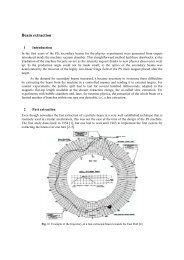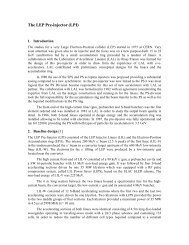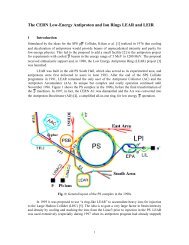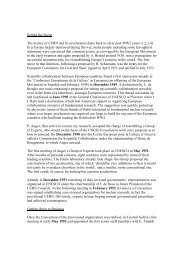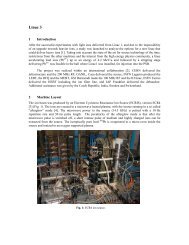RF gymnastics in the PS - CERN
RF gymnastics in the PS - CERN
RF gymnastics in the PS - CERN
Create successful ePaper yourself
Turn your PDF publications into a flip-book with our unique Google optimized e-Paper software.
Fig. 6: ‘Funnell<strong>in</strong>g’ with an <strong>RF</strong> dipole <strong>in</strong> <strong>the</strong> <strong>PS</strong>B–<strong>PS</strong> transfer l<strong>in</strong>eFig. 7: Average and peak beam current dur<strong>in</strong>g a complete acceleration cycle with <strong>the</strong> <strong>RF</strong> dipoleThe needs of <strong>the</strong> upgrade programme launched <strong>in</strong> 1983 and based on <strong>the</strong> Antiproton Collector(ACOL) could, however, not be met with <strong>the</strong> previous methods of preparation of <strong>the</strong> antiprotonproduction beam. Bunch rotation of <strong>the</strong> antiproton bunches enter<strong>in</strong>g ACOL was <strong>in</strong>deed foreseen, toquickly reduce <strong>the</strong>ir energy spread by a large factor, without resort<strong>in</strong>g to any cool<strong>in</strong>g. Hence <strong>the</strong>proton bunches had to have a reproducible and as short as possible bunch length. A two-step quasiadiabaticprocess was <strong>the</strong>refore proposed, us<strong>in</strong>g bunch merg<strong>in</strong>g and batch compression [13].Merg<strong>in</strong>g pairs of bunches is obta<strong>in</strong>ed at constant B field by chang<strong>in</strong>g <strong>the</strong> <strong>RF</strong> voltage seen by <strong>the</strong>beam from h=20 to h=10, with <strong>the</strong> h=10 stable phase centred <strong>in</strong> <strong>the</strong> middle of <strong>the</strong> h=20 buckets (Fig.8).Fig. 8: <strong>RF</strong> voltages and buckets dur<strong>in</strong>g bunch-pair merg<strong>in</strong>g5



